How to Build a High-Converting Affiliate Marketing Funnel in 5 Steps
There are many paths to making an affiliate conversion.
But a simple funnel can convert miles better than trying to offload cold traffic as quickly as possible to a merchant or advertiser. Especially so when you’re promoting more expensive or complex products.
To work less and sell more in the long run, you need to focus on providing value, building trust, and recommending the right products while using urgency and scarcity in a tasteful way.
Want to build a high-converting affiliate marketing funnel that’s low maintenance and creates compounding results? Read on to learn:
- What is an affiliate marketing funnel?
- What a sales funnel for affiliate marketing looks like
- The benefits of creating a funnel for affiliate marketing
- 5 Steps to build an affiliate marketing funnel that converts
- And how to monitor and optimize your affiliate funnel once it's live
Let's get started!
What is an affiliate marketing funnel?
An affiliate marketing funnel is a thoughtfully mapped out path designed to help leads go from prospect to customer for an affiliate product you promote, in the shortest time. A good funnel always delivers customized value through each stage of a buyer’s journey.
There are four key stages in the buyer's journey:
- Awareness – Prospects become aware of a problem.
- Consideration – They start to learn more about possible solutions.
- Conversion – They make a decision to purchase.
- Loyalty – A positive experience leads to trust and repeat buys.

That’s exactly the journey your affiliate marketing funnel guides them through.
What a sales funnel for affiliate marketing looks like
Following the principles of the buyer's journey, an affiliate marketing sales funnel should look something like this:
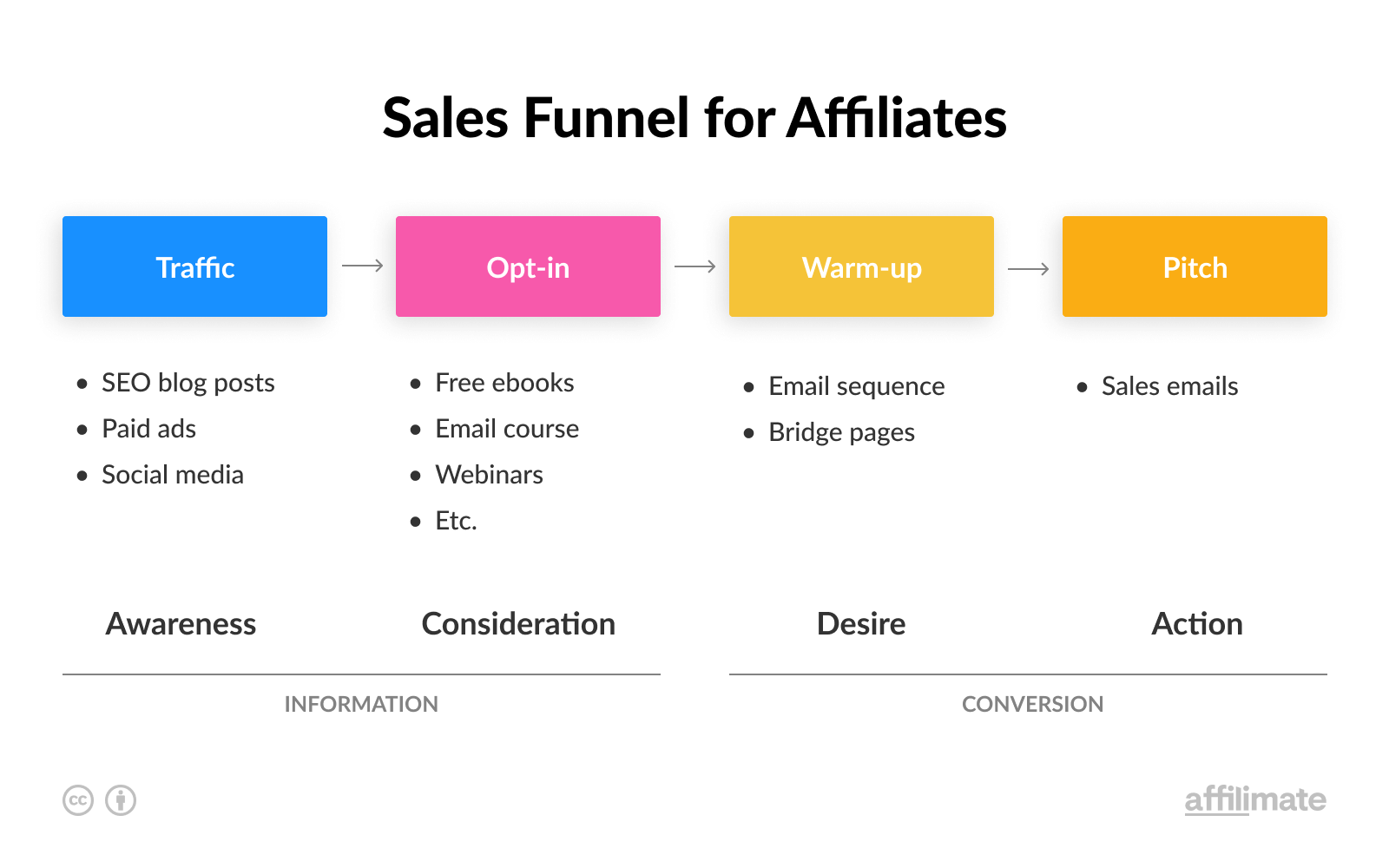
The first stage is to drive traffic to your offer using blog posts written with SEO in mind, paid ads to a free offer, and social media platforms like Pinterest.
The second stage is where you convert that traffic with a free offer. The goal is to get them on your email list where you have better control over their journey, and the opportunity to sell to them again and again.
The third stage allows you to warm up your audience for better conversion rates before you finally pitch your offer in the fourth and final stage.
5 Benefits of a Sales Funnel for Affiliate Marketing
Wondering why you should go through the process of creating an affiliate marketing funnel when you could just add your links in your blog posts, or put up ads and sell to cold prospects instead?
Here are some of the reasons why you should definitely invest in creating an affiliate marketing funnel.
1. Reach more prospects
Given that most people start their purchase journey with a search, you’ll be missing out on a good majority of potential buyers – up to 72% according to Pardot if you are using only ads.

But it’s not just creating blog posts and adding affiliate links to them either.
At this stage buyers are looking for educational material, so creating free content around that means you have a better chance of getting more people to buy through your affiliate links eventually.
2. Boost your conversion rates
Lead nurturing results in better conversion rates, and it’s no surprise why.
Before you can nurture leads, you need to first understand them. That understanding means you can deliver better targeted/personalized help, increase brand trust and conversions.
With an affiliate marketing funnel, you also get the chance to track every part of your funnel so you can easily spot and fix issues in your process. Are people engaging with your emails but not clicking over to the offer page? Or maybe they seem excited about the offer until they click over to the offer page and then you hear crickets.
With a step-by-step funnel, you aren’t left guessing. You’ll know exactly where the drop-off happens and can easily pinpoint what to do in order to fix it.
3. Bag repeat sales
One of the best reasons to build an affiliate marketing funnel instead of simply adding links to a blog post or driving ad traffic directly to a sales page is the opportunity to build your own buyers list.
Buyers list – A carefully built list of people who subscribe to your email list and you know are willing and ready to buy relevant products, because they've done so in the past.
This means that instead of working hard to get one sale while the merchant you’re sending leads to builds their list from your efforts, you’ll have your own list that you can sell more products down the road.
4. Increase brand trust and authority
An affiliate funnel is designed to give customers value through every stage of the buyer’s journey. So even if they end up not buying from you, there’s no negative association because you didn’t merely interrupt them on a Facebook or Instagram feed, you delivered value.
This leads to more conversions and brand trust.
Also, because of all the education leads get, they know exactly what they want and only buy when they are truly ready. This is key to lessen buyer’s remorse, increase customer satisfaction, and mitigate refund requests.
5. Command higher affiliate commissions
Product owners know that not all traffic is created equal, so they are willing to pay more for better quality leads.
Even if you aren’t sending a boatload of traffic yet, when the traffic you send to merchants converts at a higher than average rate and asks for fewer refunds, you get leverage to negotiate higher affiliate commissions.
How To Build An Affiliate Marketing Funnel in 5 Steps
Ready to create an affiliate marketing funnel that converts more prospects and gives you leverage to ask for higher commissions?
Here’s our five-step system to help you do just that.

We’ll be working backward through these steps so that we have a solid foundation for an effective funnel.
Step 1. Choose your offer
The pillar of a solid affiliate marketing funnel is a great offer. If you don’t already have one, here are some tips to guide you:
- Choose a product you are familiar with. Double points if you already use and love it.
- Relevance to your audience is a must. If prospects don't understand why you're pitching a product to them, they're not going to buy.
- Check online reviews on sites like G2 and Capterra. Even the social media handles for the product can help you make sure it has a great reputation.
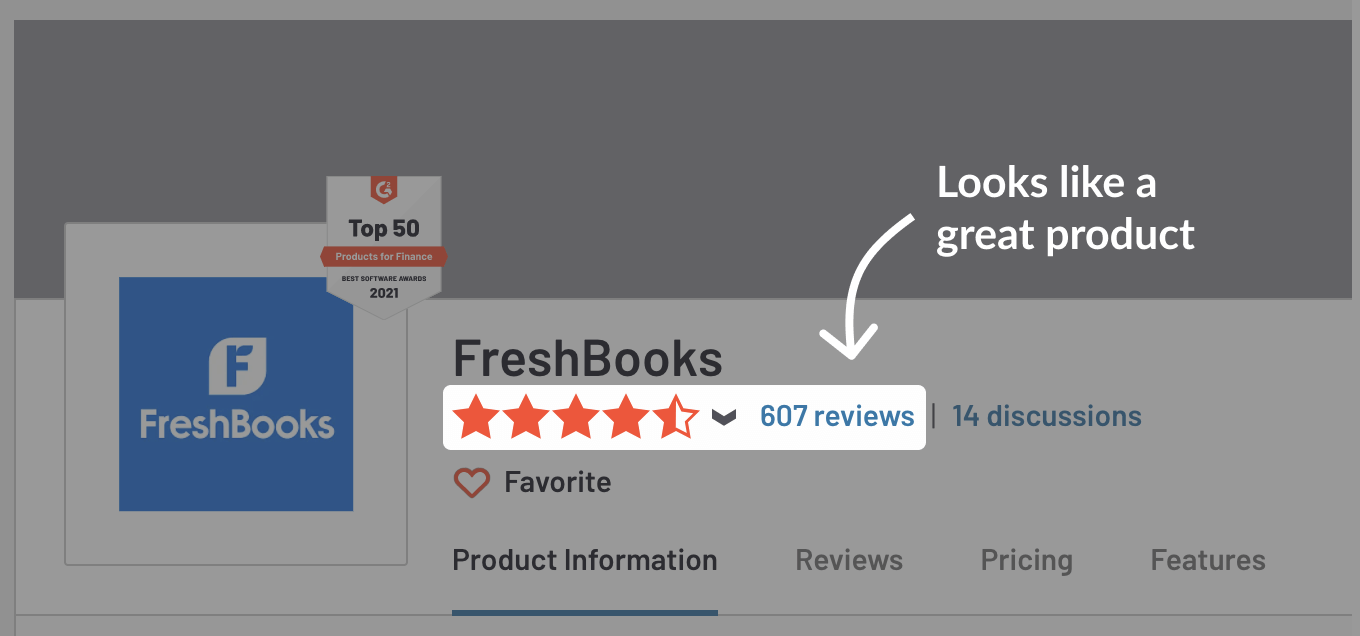
- Watch out for the conversion rate. If it’s a private program you may have to test before you know. But for programs on networks like ShareASale, it’s easy to see this right away. Bear in mind that even though it’s a solid starting point, numbers reported by networks might not apply to your audience or content.
- Are there enough tools and resources to help you with promo? For example, product images, manufacturer specifications, and an understanding of the product's core selling points.
- What about the cookie life and actual commission? How many of these will you realistically need to sell to turn a meaningful profit?
- How does the merchant promote the product to their own subscribers? Sign up for the brand's email list and see how they promote their product. Plus, the last thing you want to do is send your audience to a site that doesn't respect their inbox.
These are just some of the things you should consider before picking an affiliate product to promote.
Don't know where to start? Check out these roundups to find a great affiliate program:
- Best Outdoor Affiliate Programs
- Best Photography Affiliate Programs
- Best Travel Affiliate Programs
- Best Language Learning Affiliate Programs
- Amazon Associates Alternatives
Step 2. Create a bridge page
Sometimes you find the perfect offer but the sales page looks like something out of a 90s movie, or the copy is just plain bad.
This is where a bridge page really comes in handy.
Even if the product has a stellar sales page, the bridge page is your opportunity to connect with your audience and stand out from the rest of the affiliate army before you send them off to the sales page.
Most successful affiliate marketers include a short video where they introduce themselves, share a review and maybe some testimonials, a call to action, and sometimes a free gift.
Alternatively if it's your own product, getting testimonials from your affiliates is another great way to layer on social proof.
Like in this squeeze page for one of marketer Chelsea Clarke’s promotions.
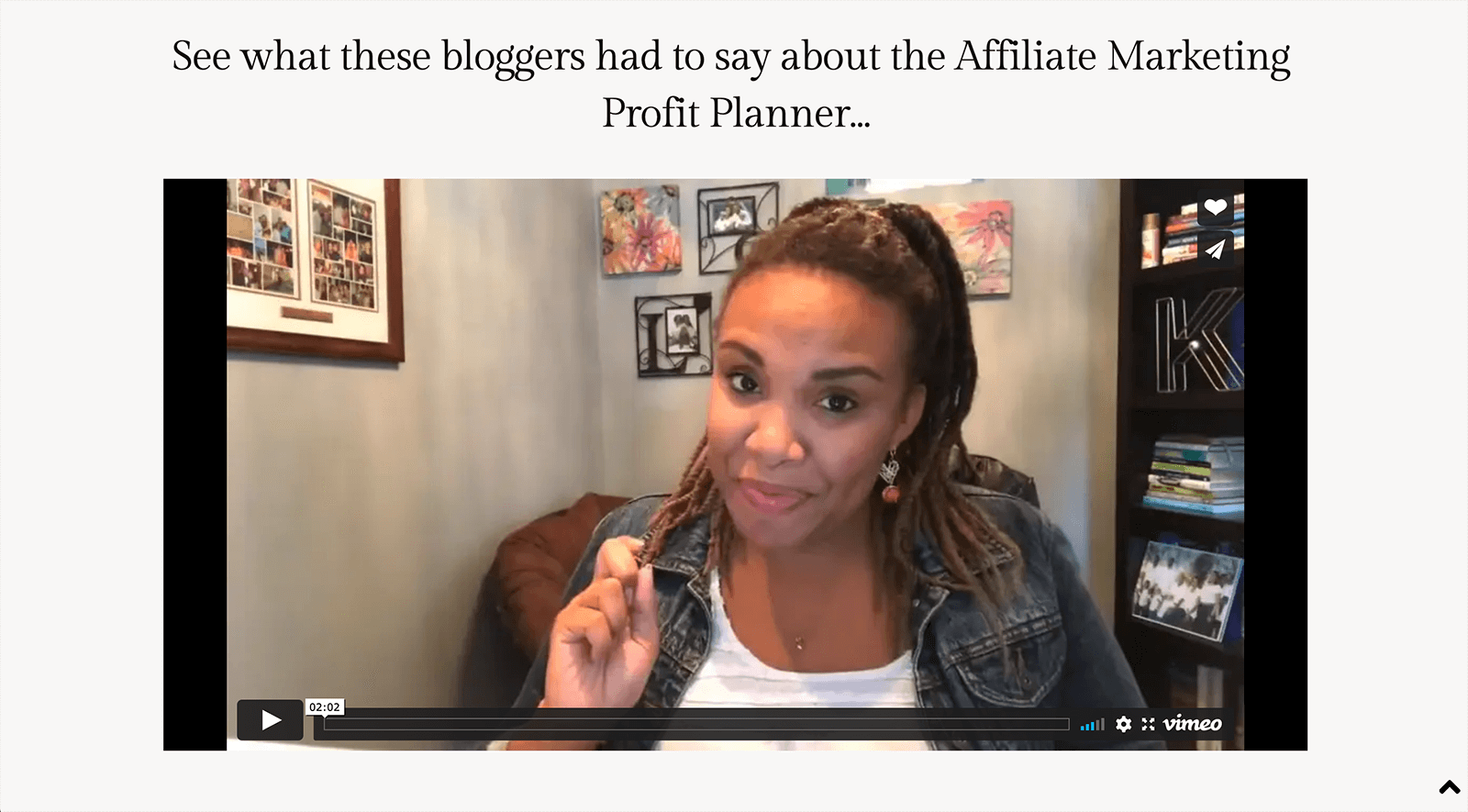
To create a bridge page, you’ll need a landing page builder like Clickfunnels or Leadpages, but if you use WordPress, you can easily create a beautiful landing page using Elementor.
Step 3. Create your opt-in and email automation
One of the best parts of an affiliate marketing funnel is automation.
You set up an opt-in to capture leads and an email series that guides them to eventually buy your affiliate product.
That way, you do the work upfront then constantly generate affiliate income after, even when you aren’t actively promoting a product.
If you run a food and cooking website for example, you could start with an optin for your best Instant Pot recipes to promote an Instant Pot.
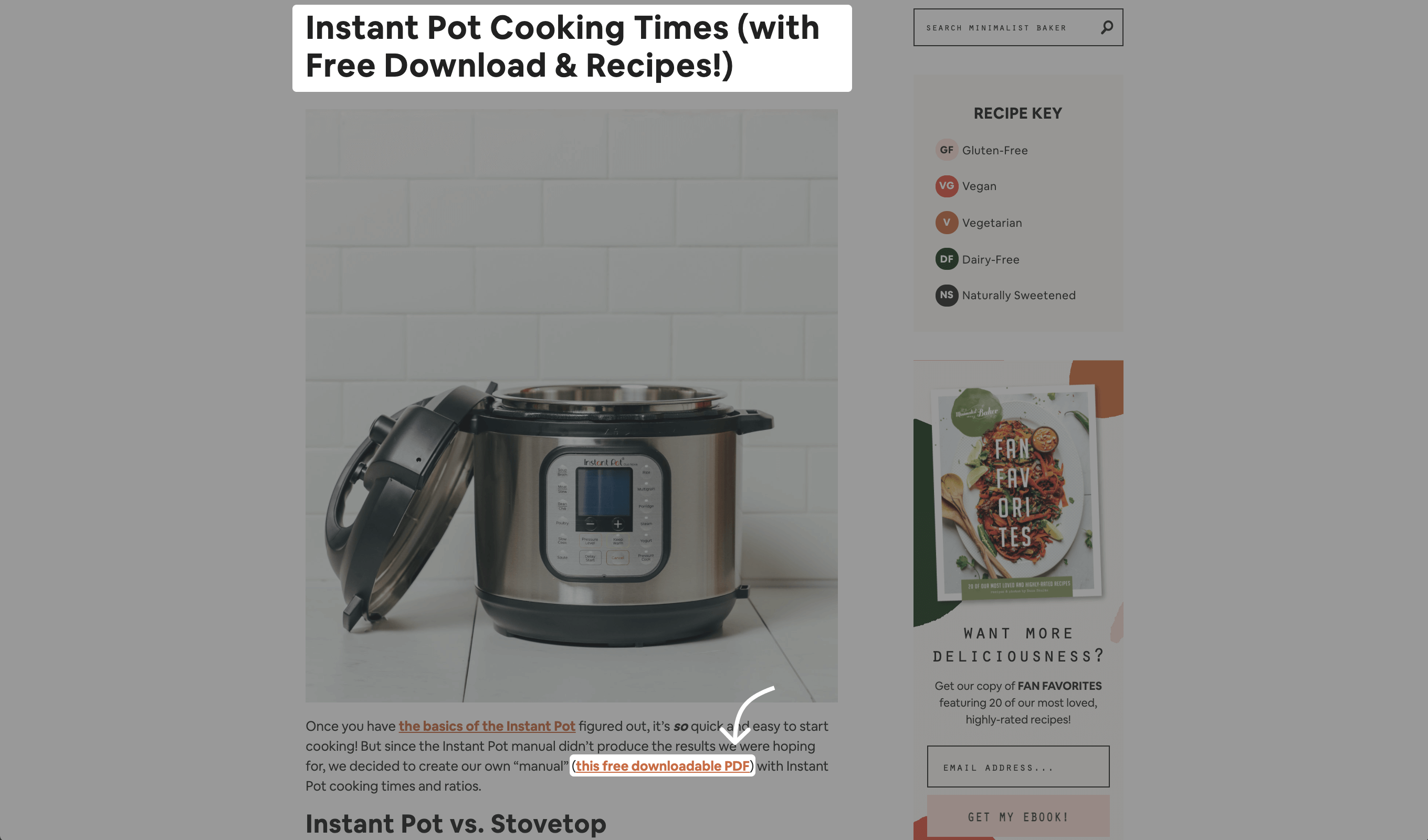
Using your preferred email service provider, you then create an email series that will lead new subscribers through:
- Your favorite Instant Pot recipes.
- How to recreate them with common ingredients
- How to best use an Instant Pot (highlighting problems you typically have cooking the same recipes on a stove)
- The Instant Pot model you use and why it’s best (a pitch for your Instant Pot affiliate product)
- A discount or another FOMO tactic
- And so forth
From here, some people like to include upsells to generate even more revenue, and downsells to capture otherwise lost sales.
Step 4. Create a landing page and thank you pages
Once you have an opt-in and an email series set up, the next step is to get people into your series.
For this, you need a landing page for your opt-in. Let’s take a look at this one.
A good opt-in landing page will:
- Make a bold and relevant promise – What will your freebie help them achieve? That should be the intro of your opt-in page. For this opt-in, it’s to remove the confusion associated with retaining customers.
- List benefits, not features – Even though you want to list the features down the page where possible – especially for advanced audiences – you should describe relatable benefits above the fold.
- Use clear and visible call to actions. Avoid choosing colors for your call-to-action (such as the signup button) which are prominent throughout your site. Pick something that'll stand out.
- Include social proof where possible. That’s testimonials, recommendations, or even just the number of people who already subscribed.
- Highlight some of the most unique features. These can be your favorite features, or features that might answer common objections people have before purchasing.

Once you’ve set up an optimized landing page, you’ll need to also create a thank you page so you start connecting with new subscribers right after they join your list.
This is a good place to showcase your personality, remind them to whitelist your emails, and point them to the next steps.
Step 5. Drive traffic to your landing page
You know how you pour water through a funnel, that’s exactly what this final step is all about; pouring leads into your affiliate funnel.
Some of the best ways to do this are implementing ads (the fastest way), or social media marketing and search engine optimization which is slower to start but delivers great ROI.
Drive traffic with ads
When most affiliate marketers think of ads, they think of driving traffic directly to the affiliate sales page, or a bridge page.
But there’s a better way. Why not minimize your cost per click by driving them to a free page that leads them into your funnel instead. An offer that gets them on your list so you can sell to them over and over again.
It could be a landing page for an opt-in like this one:
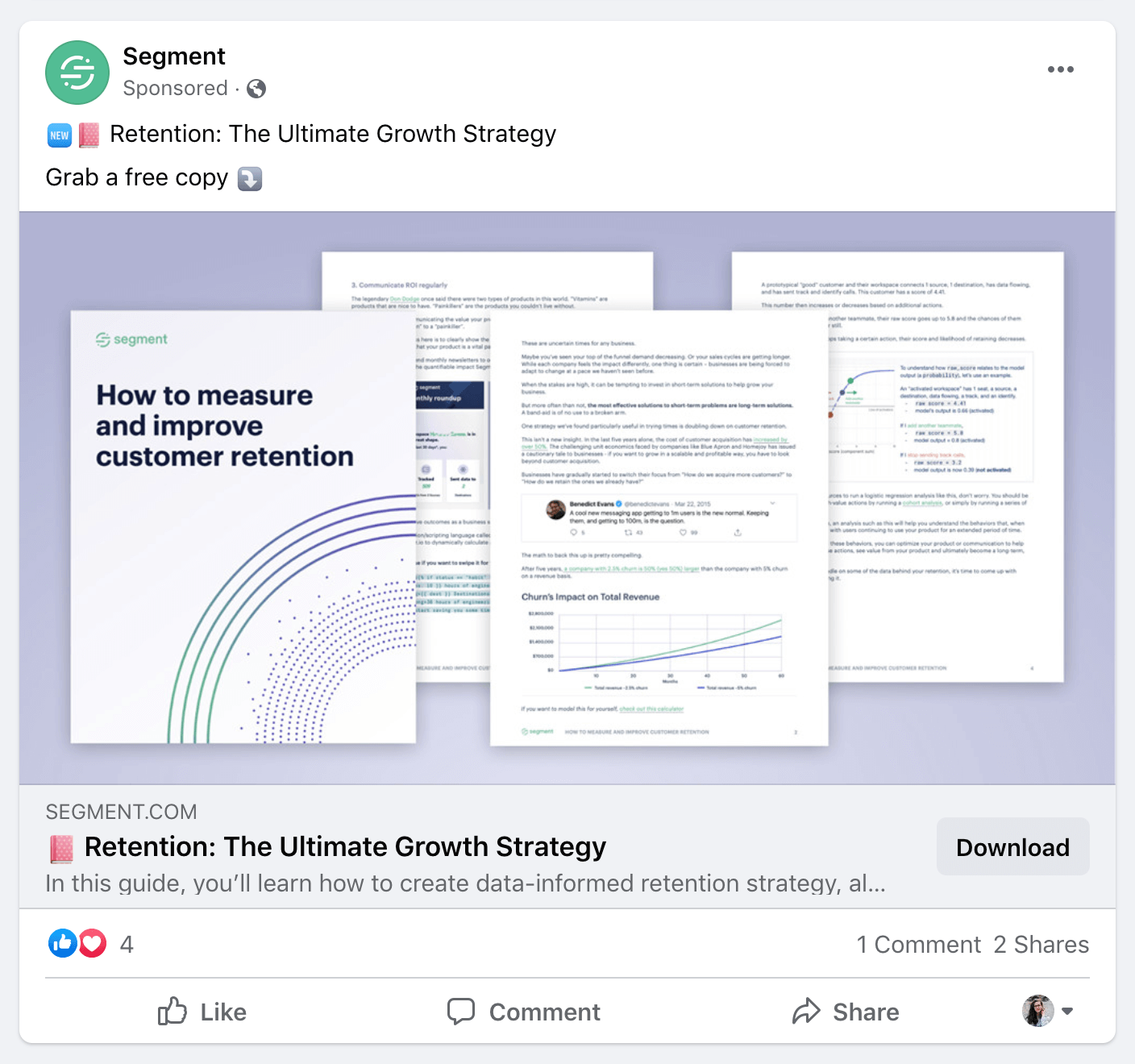
Or for a blog post like this one:

Use social media marketing
Another popular way to drive traffic to your free offer is to share them on social media. Here's an example of a blog post that promotes WordPress plugins, being shared on Twitter:
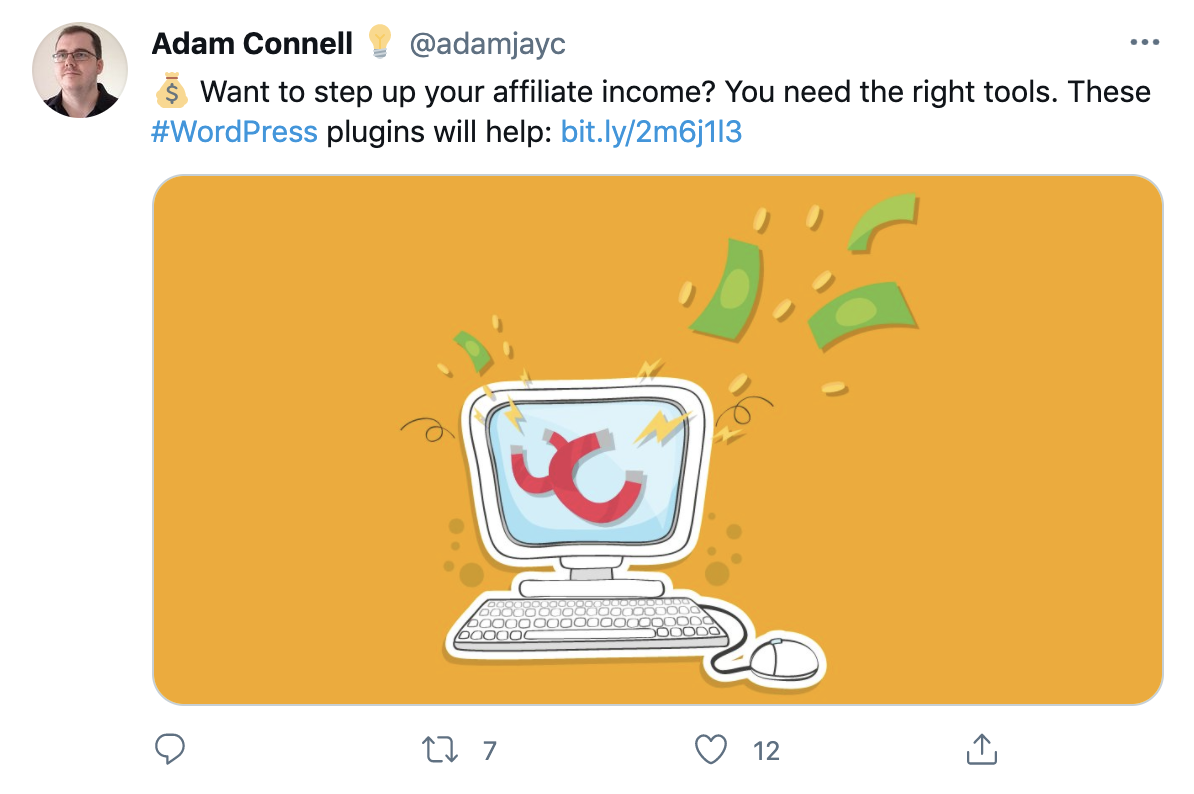
Like with everything else marketing, social media requires a strategy for success.
To see results, you’ll need to:
Choose the right platform. Where does your target audience hang out the most?
If your affiliate product is a house cleaning product, for example, it should make better sense to promote on Pinterest or Instagram than on LinkedIn. Another way is to use the data you already have in Google analytics to decide where your audience comes from.
Deliver value. Most of the time, affiliate marketers make the mistake of dumping affiliate links on social without sharing anything else. If your social media handle is full of non-stop promos littered with product promos and hashtags, it’s time to switch things up.
Aim to share posts that teach, encourage, and inspire up to 90% of the time.
Invest in Search Engine Optimization (SEO)
SEO is the optimization of your website content so that it’s more visible in search. Most times, this will mean creating blog posts that guide your readers through the buyer’s cycle by targeting buyer intent keywords.
For a comprehensive strategy, you’ll need to target:
- Informational keywords which typically have higher search volumes and are great for list building e.g “how to remove wine from a tablecloth”
- Comparison keywords e.g. “best red wine remover”
- Product keywords e.g. “Clorox review”
Whatever channel you choose to use to promote your funnel, remember to track and monitor results so you can figure out where to focus your efforts.
Monitor and optimize your affiliate sales funnel
Creating an affiliate marketing funnel doesn’t need to be a complicated process.
It should be as simple as choosing the right offer, creating relevant opt-ins and bridge pages, setting up an email automation, and landing pages that you can drive traffic to. But if you want to make the most of it, it doesn’t stop there.
The best affiliate marketers constantly track and monitor their processes for opportunities to improve.
Want to understand exactly landing pages, links, and call-to-actions are converting for you? Take Afflimate for a free 15-day trial run today.

